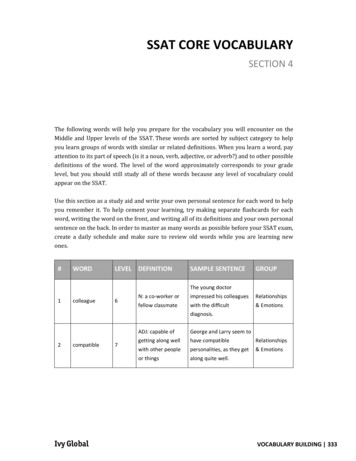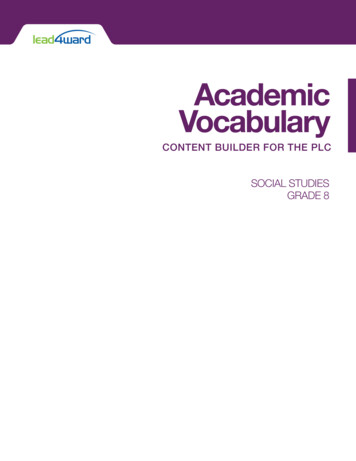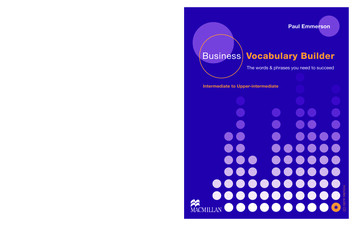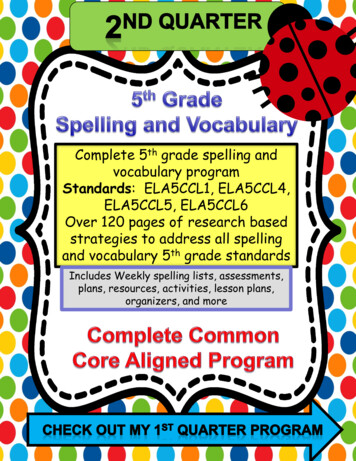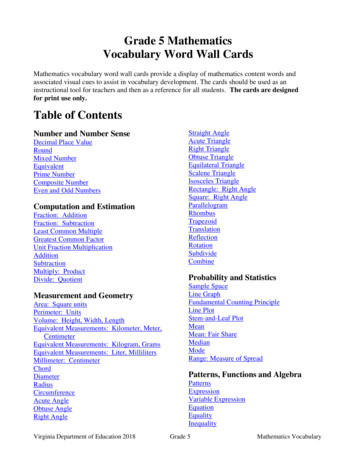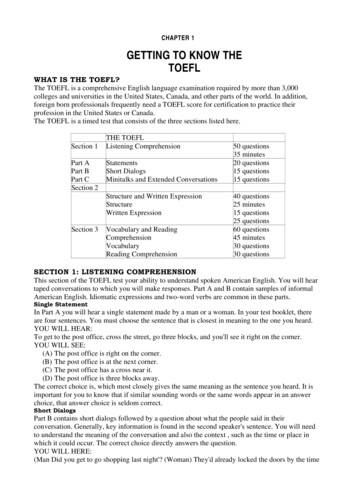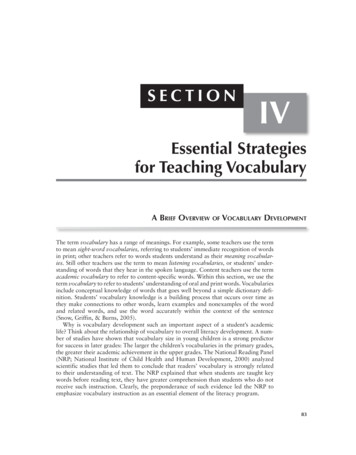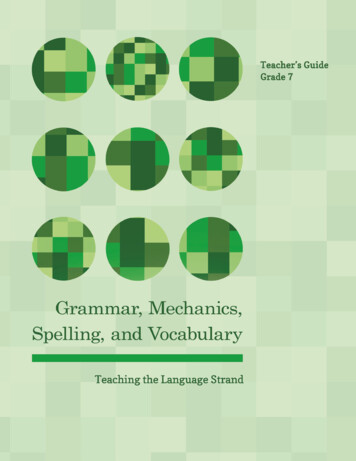
Transcription
ColonizationDefinition: The act or process of establishing a colony orcolonies; the spreading of a species into a new habitat.
RevolutionDefinition: An overthrow and the thorough replacement ofan established government or political system by the peoplegoverned.
Declaration of IndependenceDefinition: A statement adopted by the ContinentalCongress on July 4, 1776, which announced that the thirteenAmerican colonies, then at war with Great Britain, regardedthemselves as independent states, and no longer a part of theBritish Empire.
ConstitutionDefinition: A framework oflaws and principles thatestablish the function, nature,offices, powers, and limits of agovernment. The Constitutionof the United States is theframework for the nationalgovernment of the U.S.
Westward ExpansionDefinition: The acquisition of territories, like the LouisianaPurchase, resulting in more and more land for Americansuntil eventually reaching the Pacific ocean.
SectionalismDefinition: Excessive concern for the interests of one groupor area to the detriment of the whole.
Civil WarDefinition: A warbetween organized groupswithin the same nationstate or republic; TheAmerican Civil War(1861–1865) was a civilwar fought over thesecession of theConfederate States.
ReconstructionDefinition: Efforts made in the United States between 1865and 1877 to restructure the political, legal, and economicsystems in the states that had seceded from the Union.
13 English ColoniesDefinition: Thecolonies on theAtlantic coast ofNorth Americafoundedbetween 1607(Virginia) and1733 (Georgia).
Absolute and Relative ChronologyDefinition: Chronology isthe science of locatingevents in time. A chronologymay be either relative -- thatis, locating related eventsrelative to each other -- orabsolute -- locating theseevents to specific dates in aChronological Era.
Significant Dates1607: Founding of Jamestown1620: Arrival of Pilgrims and Signing the Mayflower Compact1776: Adoption of the Declaration of Independence1787: Writing the U.S. Constitution1803: Louisiana Purchase1861-1865: Civil War
Mayflower CompactDefinition: An agreement reached by the Pilgrims on the shipthe Mayflower in 1620, just before they landed at PlymouthRock. The Mayflower Compact bound them to live in a civilsociety according to their own laws.
Fundamental Orders ofConnecticutDefinition: The basic law of the Connecticut colony from1639 to 1662, formally adopted (Jan. 14, 1639) byrepresentatives from the towns of Hartford, Wethersfield,and Windsor, meeting at Hartford.
Virginia House of BurgessesDefinition: First representative government group in theAmerican colonies; established by the Virginia Company,who created the body as part of an effort to encourageEnglish craftsmen to settle in North America and to makeconditions in the colony more agreeable for its currentinhabitants.
VirtueDefinition: The quality of being morally good or righteous.
Proclamation of 1763Definition: Proclamationby Britain at the end ofthe French and IndianWar that prohibitedsettlement by whites onIndian territory.
Intolerable ActsDefinition: Also known as the Coercive Acts; a series ofBritish measures passed in 1774 and designed to punish theMassachusetts colonists for the Boston Tea Party.
Stamp ActDefinition: A law passed in the British Parliament in 1765introducing a tax on legal documents, commercial contracts,licenses, publications, and playing cards in the NorthAmerican colonies.
MercantilismDefinition: An early modern European economic theory andsystem that actively supported the establishment of coloniesthat would supply materials and markets and relieve homenations of dependence on other nations.
ParliamentDefinition: A nation's legislative body, made up of electedand sometimes nonelected representatives.
French and Indian WarDefinition: War fought between Great Britain and its twoenemies, the French and the Indians of North America. Mostof the battles were in Canada. American colonists, includingGeorge Washington, fought with the British in this war,which lasted from 1754 to 1763. The British won the warand won the right to keep Canada and several otherpossessions in the New World.
Abigail AdamsThe wife of John Adams, who was thesecond President of the United States,and the mother of John Quincy Adams,the sixth. Adams is remembered for themany letters she wrote to her husbandwhile he stayed in Philadelphia,Pennsylvania, during the ContinentalCongresses. John frequently sought theadvice of Abigail on many matters, andtheir letters are filled with intellectualdiscussions on government and politics.
John AdamsThe second President of the UnitedStates (1797–1801), having earlierserved as the first Vice President ofthe United States. An AmericanFounding Father, he was astatesman, diplomat, and a leader ofAmerican independence from GreatBritain. Well educated, he was anEnlightenment political theorist whopromoted republicanism.
Wentworth CherwellAn African-American teacher, American Revolutionary Warveteran, assessor, auditor, selectman and Justice of thePeace. He is considered by some the first African Americanelected to public office, as well as the first archaeologist inNew Hampshire.
Samuel AdamsAn American statesman, politicalphilosopher, and one of theFounding Fathers of the UnitedStates. As a politician in colonialMassachusetts, Adams was aleader of the movement thatbecame the American Revolution,and was one of the architects of theprinciples of Americanrepublicanism that shaped thepolitical culture of the UnitedStates.
Mercy Otis WarrenA political writer and propagandist of the AmericanRevolution. During the years before the AmericanRevolution, Warren published poems and plays that attackedroyal authority in Massachusetts and urged colonists to resistBritish infringements on colonial rights and liberties. Duringthe debate over the United States Constitution in 1788, sheissued a pamphlet, written under the pseudonym,"A Columbian Patriot," that opposed ratificationof the document and advocated the inclusion ofa Bill of Rights.
James ArmisteadThe first African American double spy. An African Americanslave, Armistead was owned by William Armistead inVirginia during the American Revolution.
Benjamin FranklinOne of the Founding Fathers of theUnited States. Franklin was a leadingauthor, printer, political theorist,politician, postmaster, scientist,musician, inventor, satirist, civicactivist, statesman, and diplomat. As ascientist, he was a major figure in theAmerican Enlightenment and thehistory of physics for his discoveriesand theories regarding electricity.
Bernardo de GalvezA Spanish military leader and colonialadministrator who served as colonialgovernor of Louisiana and Cuba, andlater as Viceroy of New Spain. Galvezaided the American Thirteen Colonies intheir quest for independence and ledSpanish forces against Britain in theRevolutionary War, defeating the Britishat the Siege of Pensacola (1781) andreconquering Florida for Spain.
Crispus AttucksAn American slave, merchant seaman and dockworker ofWampanoag and African descent. He was the first personshot to death by British redcoats during the BostonMassacre, in Boston, Massachusetts.
King George IIIKing of Great Britain and King of Irelandfrom 25 October 1760 until the union ofthese two countries on 1 January 1801,after which he was King of the United Kingdom of GreatBritain and Ireland until his death. His life and reign weremarked by a series of military conflicts involving hiskingdoms, much of the rest of Europe, and places fartherafield in Africa, the Americas and Asia. Early in his reign,Great Britain defeated France in the Seven Years' War,becoming the dominant European power in North Americaand India.
Haym SalomonA Spanish and Portuguese Jew whoimmigrated to New York from Polandduring the period of the AmericanRevolution. He was a broker and helpedconvert the French loans into ready cashby selling bills of exchange for RobertMorris, the Superintendent of Finance.In this way he aided the ContinentalArmy during the AmericanRevolutionary War against GreatBritain.
Patrick HenryAn attorney, planter and politician whobecame known as an orator during themovement for independence inVirginia in the 1770s. A FoundingFather, he served as the first and sixthpost-colonial Governor of Virginia,from 1776 to 1779 and from 1784 to1786. Henry led the opposition to theStamp Act of 1765 and is rememberedfor his "Give me Liberty, or give meDeath!" speech.
Thomas JeffersonAn American Founding Father, the principal author of theDeclaration of Independence (1776) and the third Presidentof the United States (1801–1809). At the beginning of theAmerican Revolution, he served in the ContinentalCongress, representing Virginia and then served as awartime Governor of Virginia (1779–1781).
Marquis de LafayetteA French aristocrat and military officer born in France.Lafayette served as a major-general in the ContinentalArmy under George Washington in the AmericanRevolutionary War and a leader of the Garde nationaleduring the French Revolution.
Thomas PaineAn English-American political activist, author, politicaltheorist and revolutionary. As the author of two highlyinfluential pamphlets at the start of the AmericanRevolution, he became one of the Founding Fathers of theUnited States.
George WashingtonOne of the Founding Fathers of theUnited States, serving as thecommander-in-chief of the ContinentalArmy during the AmericanRevolutionary War and later as the newrepublic's first President. He alsopresided over the convention thatdrafted the Constitution.
Battle of Lexington and ConcordDefinition: The first military engagements of the AmericanRevolutionary War. They were fought on April 19, 1775.The battles marked the outbreak of open armed conflictbetween the Kingdom of Great Britain and its thirteencolonies in the mainland of British North America.
Battle of SaratogaDefinition: This battle conclusively decided the fate ofBritish General John Burgoyne's army in the American Warof Independence and is generally regarded as a turning pointin the war.
Battle of YorktownDefinition: A victory by a combined American and Frenchforce led by General George Washington and the Comte deRochambeau over a large British army commanded byGeneral Lord Charles Cornwallis. The surrender ofCornwallis's army caused the British government tonegotiate an end to the American Revolutionary War.
Winter at Valley ForgeDefinition: Valley Forge was the site of the camp of theAmerican Continental Army over the winter of 1777–1778in the American Revolutionary War. This was a time of greatsuffering for George Washington's army—but also a time ofretraining and rejuvenation.
Articles of ConfederationDefinition: The agreement made by the original 13 states in1777 establishing a confederacy to be known as the UnitedStates of America; replaced by the Constitution of 1788.
Treaty of ParisDefinition: A treaty signed on September 3, 1783, to end theRevolutionary War .
Constitutional ConventionDefinition: The convention in Philadelphia (1787) ofrepresentatives from each of the former Colonies, exceptRhode Island, at which the constitution of the United Stateswas framed.
The Great CompromiseDefinition: An agreement between large and small statesreached during the Philadelphia Convention of 1787 that inpart defined the legislative structure and representation thateach state would have under the United States Constitution.
Three-Fifths CompromiseDefinition: A compromise betweenSouthern and Northern statesreached during the PhiladelphiaConvention of 1787 in which threefifths of the enumerated populationof slaves would be counted forrepresentation purposes regardingboth the distribution of taxes and theapportionment of the members of theUnited States House ofRepresentatives.
RatificationDefinition: To confirm by expressing consent, approval, orformal sanction: to ratify a constitutional amendment.
TariffDefinition: A duty levied by a government on imported orexported goods.
TaxationDefinition: The system whereby taxes are levied on sometypes of income, earnings, or purchases.
War of 1812Definition: A military conflict fought between the forces ofthe United States and those of the British Empire.
Washington’s Farewell AddressDefinition: A letter written by the first American President,George Washington, to "The People of the United States".Washington wrote the letter near the end of his second termas President, before his retirement to his home MountVernon.
Monroe DoctrineDefinition: A policy of the United States introduced onDecember 2, 1823. It stated that further efforts by Europeannations to colonize land or interfere with states in North orSouth America would be viewed as acts of aggressionrequiring U.S. intervention.
Andrew JacksonSeventh president of the United States; his twoadministrations, famous for ideologies labeled ‗JacksonianDemocracy‘, encouraged participation in government by thepeople, particularly the middle class.
SuffrageDefinition: The right to vote in public elections.
Indian Removal ActDefinition: A law passed by the United States Congress andsigned by President Andrew Jackson to facilitate theremoval of American Indian tribes living east of theMississippi River in the United States to lands further west.
Trail of TearsDefinition: The route along which the United Statesgovernment forced several tribes of Native Americans,including the Cherokees, Seminoles, Chickasaws, Choctaws,and Creeks, to migrate to reservations west of theMississippi River in the 1820s, 1830s, and 1840s.
Northwest OrdinanceDefinition: The act of Congress in 1787 providing for thegovernment of the Northwest Territory and setting forth thesteps by which its subdivisions might become states.
Manifest DestinyDefinition: The doctrine or belief prevalent in the 19thcentury that the United States had the God-given right toexpand into and possess the whole of the North Americancontinent.
Louisiana PurchaseDefinition: A treaty signed with France in 1803 by whichthe U.S. purchased for 15,000,000 the land extending fromthe Mississippi River to the Rocky Mountains and fromCanada to the Gulf of Mexico.
SlaveryDefinition: A system under which people are treated asproperty to be bought and sold, and are forced to work.
John Quincy AdamsThe sixth president of the United States (1825–1829). Heserved as an American diplomat, Senator, and Congressionalrepresentative. He was a member of the Federalist,Democratic-Republican, National Republican, and laterAnti-Masonic and Whig parties. Adams was the son offormer President John Adams and Abigail Adams. As adiplomat, Adams played an important role in negotiatingmany international treaties, most notably theTreaty of Ghent, which ended the War of 1812.
John C. CalhounA leading politician and political theorist from SouthCarolina during the first half of the 19th century. Calhounbegan his political career as a nationalist, modernizer, andproponent of a strong national government and protectivetariffs. After 1830 he switched to states' rights, limitedgovernment, nullification and free trade. He is best knownfor his intense and original defense of slavery as somethingpositive, and for pointing the South towardsecession from the Union.
Henry ClayA lawyer, politician and skilled orator who representedKentucky separately in both the Senate and in the House ofRepresentatives. He served three different terms as Speakerof the United States House of Representatives and was alsoSecretary of State from 1825 to 1829. Clay was a dominantfigure in both the First and Second Party systems. As aleading war hawk, he favored war with Britain and played asignificant role in leading the nation to warin 1812.
Daniel WebsterA leading American statesman and senator fromMassachusetts during the period leading up to the Civil War.He first rose to regional prominence through his defense ofNew England shipping interests. He lead the opposition toDemocrat Andrew Jackson and the Democratic Party. Hewas a spokesman for modernization, banking and industry,but not for the common people whocomposed the base of his enemies inJacksonian Democracy.
Jefferson DavisAn American statesman and leader of the Confederacyduring the American Civil War, serving as President of theConfederate States of America for its entire history. Hefought in the Mexican–American War as a colonel of avolunteer regiment. He served as the United States Secretaryof War under Democratic President Franklin Pierce. As asenator, he argued against secession, but didagree that each state was sovereign and hadan unquestionable right to secede from theUnion.
Ulysses S. GrantThe 18th President of the United States (1869–1877)following his dominant role in the second half of the CivilWar. Under Grant, the Union Army defeated the Confederatemilitary and effectively ended the war with the surrender ofRobert E. Lee's army at Appomattox.
Robert E. LeeA career military officer who is bestknown for having commanded theConfederate Army of NorthernVirginia in the American Civil War.
Abraham Lincoln16th President of the United States, serving from March1861 until his assassination in April 1865. Lincolnsuccessfully led his country through its greatestconstitutional, military and moral crisis – the American CivilWar – preserving the Union while ending slavery, andpromoting economic and financial modernization.
William CarneyAn African American soldier during the American Civil Warwho received the Medal of Honor for his actions during theBattle of Fort Wagner.
Philip BazaarA Navy seaman who was awarded the United States' highestmilitary decoration for valor in combat — the Medal ofHonor — for having distinguished himself during the battlefor Fort Fisher of the American Civil War.
Battle of AntietamDefinition: Also known as the Battle of Sharpsburg,fought on September 17, 1862, near Sharpsburg, Maryland,and Antietam Creek, as part of the Maryland Campaign; wasthe first major battle in the American Civil War to take placeon Union soil. It was the bloodiest single-day battle inAmerican history, with about 23,000 casualties on bothsides.
Battle of GettysburgDefinition: Fought July 1–3, 1863,in and around the town ofGettysburg, Pennsylvania. It was thebattle with the largest number ofcasualties in the American Civil Warand is often described as the war'sturning point.
Battle of VicksburgDefinition: The final major militaryaction in the Vicksburg Campaignof the American Civil War. In aseries of maneuvers, Union Maj.Gen. Ulysses S. Grant and his Armyof the Tennessee crossed theMississippi River and drove theConfederate army of Lt. Gen. JohnC. Pemberton into the defensivelines surrounding the fortress city ofVicksburg, Mississippi.
Emancipation ProclamationDefinition: A proclamation, effective on January 1, 1863,that was issued by President Abraham Lincoln and declaredfreedom for all slaves in states still in rebellion against thefederal government.
Lee’s Surrender at AppomattoxCourt HouseDefinition: With his army surrounded, his men weak andexhausted, Robert E. Lee realized there was little choice butto consider the surrender of his Army to General Ulysses S.Grant. After a series of notes between the two leaders, theyagreed to meet on April 9, 1865, at the house ofWilmer McLean in the village of AppomattoxCourthouse. The meeting lasted approximatelytwo and one-half hours and at its conclusionthe bloodiest conflict in the nation's historyneared its end.
LibertyDefinition: The freedom to think or act without beingconstrained by necessity or force.
EqualityDefinition: Rights, treatment, quantity, or value equal to allothers in a specific group.
UnionDefinition: The act of joining together people or things toform a whole.
GovernmentDefinition: A group of people who have the power to makeand enforce laws for a country or area.
Inaugural AddressDefinition: Formal speech to mark the beginning of aleader's (like a president's, a prime minister's, etc.) term ofoffice.
Hiram Rhodes RevelsThe first non-white to serve in the United States Senate.Because he preceded any non-white in the House, he wasthe first person of color in the U.S. Congress as well. Herepresented Mississippi in 1870 and 1871 duringReconstruction.
Homestead ActDefinition: An act passed by the U.S. Congress in 1862,promising ownership of 160 acres of public land to a citizenwho lived on and cultivated it for five years.
Dawes ActDefinition: A federal lawintended to turn NativeAmericans into farmers andlandowners by providingcooperating families with160 acres of reservationland for farming or 320acres for grazing.
Morrill ActDefinition: An act of Congress (1862) granting each state30,000 acres (12,000 hectares) of land for each member ithad in Congress.
Population DistributionDefinition: The arrangement or spread of people living in agiven area.
Settlement PatternsDefinition: The way the settlement is arranged; thephysical appearance of the settlement.
ImmigrantDefinition: A person who migrates to another country,usually for permanent residence.
UrbanizationDefinition: The physical growth of urban areas as a result ofrural migration and even suburban concentration into cities,particularly the very largest ones.
IndustrializationDefinition: The process by which manufacturing industriesdevelop from within a predominantly agrarian society.
Social ClassDefinition: A broad group in society having commoneconomic, cultural, or political status.
Abolitionist MovementDefinition: Movement to endthe slave trade and emancipateslaves in western Europe andthe Americas.
TemperanceDefinition: Total abstinence from alcoholic drink.
Great AwakeningsDefinition: Series of religious revivals that swept over theAmerican colonies about the middle of the 18th century;resulted in doctrinal changes and influenced social andpolitical thought.
AmendmentDefinition: A change, correction, or improvement tosomething; an addition or alteration to a motion, bill, orconstitution.
st1AmendmentDefinition: Prohibits the making of any law respecting anestablishment of religion, impeding the free exercise ofreligion, abridging the freedom of speech, infringing on thefreedom of the press, interfering with the right to peaceablyassemble or prohibiting the petitioning for a governmentalredress of grievances.
Hudson River School ArtistsDefinition: A mid-19th century American art movementembodied by a group of landscape painters whose aestheticvision was influenced by romanticism. The paintings forwhich the movement is named depict the Hudson RiverValley and the surrounding area, including the Catskill,Adirondack, and the White Mountains.
John James AudubonA French-American ornithologist, naturalist, and painter. Hewas notable for his expansive studies to document all typesof American birds and for his detailed illustrations thatdepicted the birds in their natural habitats. His major work, acolor-plate book entitled The Birds of America (1827–1839),is considered one of the finest ornithological works evercompleted. Audubon identified 25 newspecies and a number of new sub-species.
“The Battle Hymn of the Republic”Definition: A hymn by American writer Julia Ward Howeusing the music from the song "John Brown's Body".Howe's more famous lyrics were written in November 1861and first published in The Atlantic Monthly in February1862. The song links the judgment of the wicked at the endof time (New Testament) with the American Civil War.Since that time it has become an extremely popular andwell-known American patriotic song.
TranscendentalismDefinition: A system of philosophy that regards theprocesses of reasoning as the key to knowledge of reality.
EraDefinition: A period of time made distinctive by asignificant development, feature, event, or personality.
Magna CartaDefinition: A charter establishing the rights of Englishbarons and free citizens, granted by King John atRunnymede in 1215 and regarded as the basis of civil andpolitical liberty in England.
Bill of RightsDefinition: A formal statement of the fundamental rights ofthe people of the United States, incorporated in theconstitution as Amendments 1–10, and in all stateconstitutions.
English Bill of RightsDefinition: An act passed by Parliament in 1689 whichlimited the power of the monarch. This documentestablished Parliament as the most powerful branch of theEnglish government.
Federalist PapersDefinition: A series of 85 articles or essays promoting theratification of the United States Constitution written byAlexander Hamilton, James Madison, and John Jay.
Political PartyDefinition: A political organization that typically seeks toinfluence government policy, usually by nominating theirown candidates and trying to seat them in political office.
RepublicanismDefinition: The ideology of governing a nation as arepublic, where the head of state is appointed by meansother than heredity, often through elections.
Checks and BalancesDefinition: A system that allows each branch of agovernment to amend or veto acts of another branch so as toprevent any one branch from exerting too much power.
FederalismDefinition: A political system in which several states orregions defer some powers, e.g. in foreign affairs, to acentral government while retaining a limited measure ofself-government.
Separation of PowersDefinition: The constitutional requirement that each of thethree branches of the U.S. government, executive, judicial,and legislative, be autonomous and distinct from the others.
Popular SovereigntyDefinition: The doctrine that the people are sovereign and agovernment is subject to the will of the people; a pre-CivilWar political doctrine that held that individual states shoulddecide whether to permit slavery or not.
th13AmendmentDefinition: Outlaws slavery and involuntary servitude,except as punishment for a crime. It was passed by theSenate on April 8, 1864, by the House on January 31, 1865,and adopted on December 6, 1865. On December 18,Secretary of State William H. Seward proclaimed it to havebeen adopted. It was the first of the three ReconstructionAmendments adopted after the American Civil War.
th14AmendmentDefinition: Adopted on July 9, 1868, as one of theReconstruction Amendments. Its Citizenship Clauseprovides a broad definition of citizenship. Its Due ProcessClause prohibits state and local governments from deprivingpersons of life, liberty, or property without certain stepsbeing taken to ensure fairness. Its Equal Protection Clauserequires each state to provide equal protection under the lawto all people within its jurisdiction.
th15AmendmentDefinition: Prohibits each government in the United Statesfrom denying a citizen the right to vote based on thatcitizen's "race, color, or previous condition of servitude" (forexample, slavery). It was ratified on February 3, 1870. TheFifteenth Amendment is one of the ReconstructionAmendments.
Alexander HamiltonA Founding Father, soldier, economist,political philosopher, one of America's firstconstitutional lawyers and the first UnitedStates Secretary of the Treasury. As Secretaryof the Treasury, Hamilton was the primaryauthor of the economic policies of the GeorgeWashington administration, especially thefunding of the state debts by the Federalgovernment, the establishment of a nationalbank, a system of tariffs, and friendly traderelations with Britain. He became the leaderof the Federalist Party.
James MadisonAn American statesman and political theorist, and the fourthPresident of the United States (1809–1817). He is hailed asthe ―Father of the Constitution‖ for being instrumental in thedrafting of the United States Constitution and as the keychampion and author of the United States Bill of Rights.
George MasonAn American Patriot, statesman and a delegate from Virginiato the U.S. Constitutional Convention. Along with JamesMadison, he is called the "Father of the United States Bill ofRights.‖ For these reasons he is considered one of the"Founding Fathers" of the United States.
Nullification CrisisDefinition: A sectional crisis during the presidency ofAndrew Jackson created by South Carolina's 1832Ordinance of Nullification. This ordinance declared by thepower of the State that the federal Tariffs of 1828 and 1832were unconstitutional and therefore null and void within thesovereign boundaries of South Carolina.
Judicial ReviewDefinition: A reassessment orre-examination by judges of adecision or proceeding by alower court or a governmentdepartment.
Marbury v. MadisonDefinition: A landmark United States Supreme Court casein which the Court formed the basis for the exercise ofjudicial review in the United States under Article III of theConstitution. The landmark decision helped define theboundary between the constitutionally separate executiveand judicial branches of the American form of government.
McCulloch v. MarylandDefinition: A landmark decision by the Supreme Court ofthe United States. The state of Maryland had attempted toimpede operation of a branch of the Second Bank of theUnited States by imposing a tax on all notes of banks notchartered in Maryland. This fundamental case establishedthe following two principles: The Constitution grants toCongress implied powers for implementing theConstitution's express powers, in order to create a functionalnational government, and state action maynot impede valid constitutional exercisesof power by the Federal government.
Gibbons v. OgdenDefinition: A landmark decision inwhich the Supreme Cou
Nov 08, 2013 · 1733 (Georgia). Absolute and Relative Chronology Definition: Chronology is the science of locating events in time. A chronology may be either relative-- that is, locating related events r
